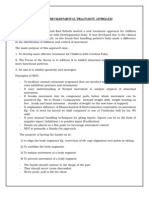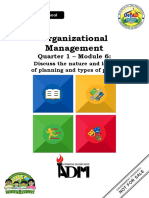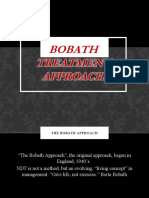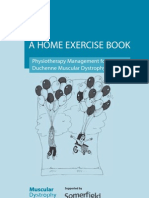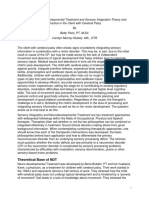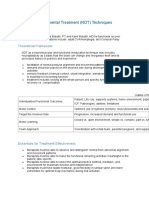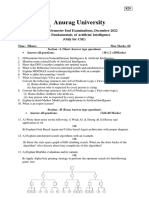Bobath Lecture
Bobath Lecture
Uploaded by
み にゅきゅCopyright:
Available Formats
Bobath Lecture
Bobath Lecture
Uploaded by
み にゅきゅCopyright
Available Formats
Share this document
Did you find this document useful?
Is this content inappropriate?
Copyright:
Available Formats
Bobath Lecture
Bobath Lecture
Uploaded by
み にゅきゅCopyright:
Available Formats
BOBATH
APPROACH
Bobath Approach is an interdisciplinary
approach to the management of cerebral
palsy involving occupational therapy,
physiotherapy and speech and language
therapy.
Bobath therapy is a holistic approach
pioneered by Dr and Mrs Bobath.
8/1/2014
The basis of the approach is to give
children an experience of normal
movement by enabling the child to
respond actively to specialized handling.
8/1/2014
Three important facts:
it is impossible to superimpose normal
movement patterns on abnormal ones, the
abnormal patterns need to be suppressed
(inhibited)
the importance of sensory-motor experience
(we do not learn a movement but the
sensation of movement)
by moving the proximal part of the body it is
possible to influence and to change the
movements of the distal parts
Treatment is planned for each child via
assessment. Some of the areas that will be
assessed are:
the patterns of movement the child
presents with;
age-appropriate movements that the child
may not be achieving or may find difficult;
the child's present capabilities;
examination of the child's posture in
different situations and positions
Principles of Treatment
Need to change the pattern of abnormal
postural tone to be able to work for enhanced
functional skills.
Use various types of handling to affect
changes:
Tone Influencing Patterns/Posture
Facilitation
Stimulation
Principles of Treatment
Systematic Preparation for Function:
Engagement with child
Address neural and non-neural components
Improve alignment of body parts
Improve muscle activity
Address sensory/perceptual needs
Give experience of and practice more normal
patterns of coordination in selected tasks to
promote transfer of skills into daily life.
Principles of Treatment
Problem Solving Approach
Using purposeful, play centred and goal directed
activities
Carry Over and Management
Active participation by patient, with gradual
reduction in handling or assistance
Self correction and self initiation
Forward looking long term outcome
Training/education of parents
8/1/2014
The Bobath Approach
The main aim of treatment is:
to encourage and increase the child's
ability to move and function in as
normal a way as possible.
to help the child to change his
abnormal postures and movements so
that he or she is able to comfortably
adapt to the environment and develop
a better quality of functional skills.
Change is Possible: Each child's postural
(muscle) tone is changeable, not only in
relation to activity and moods, but also
in response to being handled.
8/1/2014
Positioning is very important in Bobath
treatment.
Correct positioning helps improve
movements.
Experience of different positions is
necessary to improve overall body
control and reduce the risk of
unnecessary poor posture.
Handling a child using key points on the
body allows the therapist to manipulate
the child to correct their movements.
Help may be given with movements like
chewing, handling objects, moving
about, sitting or lying down.
8/1/2014
Handling = making a change
Through handling techniques the PT can
assess the childs potentials
Creates opportunities for the child to
experiment with movement and to
problem-solving for himself
Makes more normal movement possible
Changes with the response of the child
Inhibitory control: Reflex inhibiting
postures (R.I.P.)
- placed and held the patient in reflex
inhibiting postures to break up the
abnormal postural and movement patterns
- no spontaneous carry over into
movement and function occurred, as the
child had never previously experienced the
sensation of normal movements
Inhibition combined with stimulation and
facilitation
- after preparing and obtaining a more normal
postural tone the patient needs to learn to
move in many different combinations of more
normal movement patterns
- looked for possibilities of how to transmit to
the patient in order to enable them to
experience normal sensations of functional
movements they had either lost or never
developed
- The Bobaths realized the importance of
understanding normal development in order
to be able to understand abnormal
development and how to treat it.
- Then the Bobaths recognised the
importance of postural reactions (righting and
equilibrium reactions)
Dynamic treatment with control from Key
Points:
- key points of control(body parts,
mainly proximal - head, shoulders, pelvis)
from which abnormal patterns could be
controlled (inhibited), and the strength
and distribution of postural tone could be
influenced
At the same time normal movement
patterns could be facilitated or a specific
technique of stimulation could be used
From the key point of control the
therapist is able to control and guide the
movement of the whole body. The child
could be facilitated to react actively
where not actually held or controlled
8/1/2014
- The treatment should not follow rigidly the
developmental milestones
- During the treatment it is necessary to reduce
the therapists control, handing it over gradually
to the child and allowing him the control of his
own movements.
- Much guided control and repetition of the
required reactions may be necessary to assure
their quality.
Normal Development
Cephalo-caudal , caudo-cephalad, proximo-
distal, and distal-proximal
Dynamic stability before dynamic mobility
End range movement before midrange control
Symmetrically before asymmetrically
Anterior-posterior direction first then
laterally, then diagonally
Dynamic relationship between BOS, COG and
LOG (stability, readiness to move and with
weight shifting there is movement)
Physiological Flexion
Body concept (body awareness, schema,
image)
Postural control/set (orientation)
Psychological, emotional stability (security)
Muscle balance of development against
extensor group
Back musculature elongation
General Picture of Prematurity
Poor alignment / body schema
Poor stability and mobility
Structural differences: extended back,
anteriorly tilted pelvis, and changing
direction of muscles and joint
Insecurity: crying
Flexed Posture
Develops midline
Develops body awareness
Promotes security
Movement (purposeful)
Main Goal of Positioning
encourage development of flexion
avoid excessive extension
facilitate smooth antigravity limb movement
promote symmetrical posture
reduce cranio-facial flattening
provide support, containment, security
minimizes stress, promote sleep
decrease energy expenditure
provide tactile stimulation
encourage parent-infant interaction
enhance midline orientation, eye, hand,
motor control
Thank You.
You might also like
- Susan Edwards - Neurological PhysiotherapyDocument293 pagesSusan Edwards - Neurological Physiotherapyharcaian_cristina91% (22)
- Vojta Guide PDFDocument42 pagesVojta Guide PDFLakshmi Prasanna100% (3)
- Adult Hemiplegia - Martha BobathDocument185 pagesAdult Hemiplegia - Martha BobathGabriela Marinescu89% (9)
- 712385Document243 pages712385Валентина МанєтоваNo ratings yet
- Neurodevelopment TechniqueDocument64 pagesNeurodevelopment Techniquenishitpatel2002100% (5)
- Bobath Approach: Neuro-Developmental TechniquesDocument25 pagesBobath Approach: Neuro-Developmental TechniquesJAZA RIZVI100% (2)
- Bobath Approach Concepts and Principles: by DR - Shahid Shabbir DPT, Ms - NMPTDocument21 pagesBobath Approach Concepts and Principles: by DR - Shahid Shabbir DPT, Ms - NMPTrabia khalid100% (2)
- Bobath Approach: Concepts and PrinciplesDocument30 pagesBobath Approach: Concepts and PrinciplesJulia Salvio100% (1)
- NDT by Dr. Rati.Document13 pagesNDT by Dr. Rati.Anup PednekarNo ratings yet
- Proprioceptive Neuromuscular FacilitationDocument7 pagesProprioceptive Neuromuscular Facilitationpsionx100% (1)
- Physiotherapy and Occupational Therapy for People with Cerebral Palsy: A Problem-Based Approach to Assessment and ManagementFrom EverandPhysiotherapy and Occupational Therapy for People with Cerebral Palsy: A Problem-Based Approach to Assessment and ManagementRating: 5 out of 5 stars5/5 (1)
- Addressing Teacher Evaluation AppropriatelyDocument7 pagesAddressing Teacher Evaluation AppropriatelyThe Washington Post100% (1)
- Org 5Document24 pagesOrg 5Kee Jay Pondoc50% (4)
- Bobath Approach 1Document61 pagesBobath Approach 1Senthil Kumar100% (1)
- Neuro-Developmental TechniqueDocument15 pagesNeuro-Developmental Techniqueapi-442568656100% (1)
- Paediatric Neurology:: Management Practices and Evidence Based PracticesDocument41 pagesPaediatric Neurology:: Management Practices and Evidence Based PracticesNikita ChaubeNo ratings yet
- Positioning and Handling To Foster Motor FunctionDocument60 pagesPositioning and Handling To Foster Motor FunctionBambang Ulan Aeiyu100% (1)
- VojitaDocument19 pagesVojitaShemjaz ArakkalNo ratings yet
- Motor Relearning ProgrammeDocument36 pagesMotor Relearning Programmerabia khalidNo ratings yet
- Neuro Developmental Treatment (NDT) : Prepared By: Akhi Mony Clinical Physiotherapist (CPT) CRP-MirpurDocument24 pagesNeuro Developmental Treatment (NDT) : Prepared By: Akhi Mony Clinical Physiotherapist (CPT) CRP-MirpurAkhi MonyNo ratings yet
- Approaches To Therapeutic Exercise and Activity For NeurologicalDocument69 pagesApproaches To Therapeutic Exercise and Activity For NeurologicalPedro M. BorgesNo ratings yet
- Bobath ApproachDocument22 pagesBobath ApproachCedricFernandez50% (4)
- BobathDocument150 pagesBobathramesh natrayan100% (1)
- Home Plan For Hemiplegic CPDocument13 pagesHome Plan For Hemiplegic CPMaira Pervez100% (1)
- Thera Neuromotor Approaches NirDocument10 pagesThera Neuromotor Approaches NirCeline Kyla Mallo100% (1)
- NDTDocument30 pagesNDTSenthil Kumar100% (2)
- Management of Gross Motor (PT)Document63 pagesManagement of Gross Motor (PT)Xulkanain ZE100% (1)
- Rehabilitation Priciples at Children With Cerebral Palsy After NDT Bobath ConceptDocument13 pagesRehabilitation Priciples at Children With Cerebral Palsy After NDT Bobath ConceptAndrei TîrziuNo ratings yet
- 2 - Bobath CoceptDocument41 pages2 - Bobath CoceptSaba Iqbal100% (2)
- 1bobath TechniqueDocument24 pages1bobath Techniquekim100% (1)
- Physiotherapy For ChildrenDocument2 pagesPhysiotherapy For ChildrenSuleiman AbdallahNo ratings yet
- Vojta TherapyDocument12 pagesVojta TherapyAnonymous GJUb7x0No ratings yet
- Dr. Maheshwari Harishchandre Assistant Professor M.P.TH (Neurosciences)Document46 pagesDr. Maheshwari Harishchandre Assistant Professor M.P.TH (Neurosciences)Nikks Borade100% (1)
- The Rood Approach TheraExDocument8 pagesThe Rood Approach TheraExLall Jingerppang100% (1)
- Rood Approach: Ot Ead 322: Traditional Sensorimotor ApproachesDocument3 pagesRood Approach: Ot Ead 322: Traditional Sensorimotor ApproachesShekinah Gracia T. Mosquera100% (2)
- Physiotherapy in Pediatrics - NEURO MUSCULAR CONDITIONSDocument28 pagesPhysiotherapy in Pediatrics - NEURO MUSCULAR CONDITIONSKumar G PalaniNo ratings yet
- Brunnstrom ApproachDocument33 pagesBrunnstrom ApproachAISHWARYA SWAMINATHANNo ratings yet
- A Home Exercise BookDocument28 pagesA Home Exercise BookNameeta Shroff Jain100% (1)
- Roods ApproachDocument59 pagesRoods Approachsridhar_physio100% (17)
- Integrating NDT and SI-Theory and PracticeDocument7 pagesIntegrating NDT and SI-Theory and PracticePaulinaNo ratings yet
- Rood's ApproachDocument33 pagesRood's ApproachC B SENTHILKUMAR77% (13)
- New Roods ApprochDocument50 pagesNew Roods ApprochMonicca GV100% (1)
- Application of Bobath COnceptDocument61 pagesApplication of Bobath COnceptArun Kumar PT100% (3)
- Cerebral Palsy PhysiotherapyDocument10 pagesCerebral Palsy Physiotherapyvenkata ramakrishnaiah100% (1)
- Sensory-Motor Development in The First Year: By:Yohannes PurwantoDocument39 pagesSensory-Motor Development in The First Year: By:Yohannes PurwantoAndrew Aland100% (3)
- Bobath Approach NotesDocument5 pagesBobath Approach NotesJuling Perales100% (6)
- Physiotherapy in Autism ManagementDocument5 pagesPhysiotherapy in Autism Managementvenkata ramakrishnaiah100% (1)
- Roods ApproachDocument33 pagesRoods ApproachCedricFernandez100% (1)
- The Bobath LectureDocument4 pagesThe Bobath LectureAlessa LachicaNo ratings yet
- Karel Bobath - A Neurophysiological Basis For The Treatment of Cerebral Palsy-Mac Keith Press (1991)Document126 pagesKarel Bobath - A Neurophysiological Basis For The Treatment of Cerebral Palsy-Mac Keith Press (1991)atsiljes13100% (1)
- Bobath Technique For Cerebral Palsy PDFDocument2 pagesBobath Technique For Cerebral Palsy PDFHanna Rikaswani0% (1)
- Bobath ApprochDocument2 pagesBobath ApprochRùpám KanungoNo ratings yet
- Brunnstrom ApproachDocument26 pagesBrunnstrom ApproachMohaChebiNo ratings yet
- 2 Year Physical Therapy NotesDocument129 pages2 Year Physical Therapy Notesthwiseman94% (17)
- Neurodevelopmental Treatment (NDT) in Paediatrics: Victoria Prooday Manuela Ocrainschi Alda MeloDocument36 pagesNeurodevelopmental Treatment (NDT) in Paediatrics: Victoria Prooday Manuela Ocrainschi Alda MeloDnyanesh Patil100% (1)
- Hypotonia in ChildrenDocument12 pagesHypotonia in Childrenrosiuariana100% (2)
- Neuro Developmental Treatment (NDT) Techniques: HistoryDocument3 pagesNeuro Developmental Treatment (NDT) Techniques: HistoryGafencu SergiuNo ratings yet
- Rehabilitation After Stroke PDFDocument8 pagesRehabilitation After Stroke PDFBetaNo ratings yet
- Essential Mechanisms in Neurological Pediatric RehabilitationFrom EverandEssential Mechanisms in Neurological Pediatric RehabilitationNo ratings yet
- Functional Rehabilitation of Some Common Neurological Conditions: A Physical Management Strategy to Optimise Functional Activity LevelFrom EverandFunctional Rehabilitation of Some Common Neurological Conditions: A Physical Management Strategy to Optimise Functional Activity LevelNo ratings yet
- Questionnaire of Factors Influencing Students Students in Choosing Abm StrandDocument5 pagesQuestionnaire of Factors Influencing Students Students in Choosing Abm StrandNoer Dela CruzNo ratings yet
- Study Planner: Support@onlineteachers - Co.inDocument4 pagesStudy Planner: Support@onlineteachers - Co.inSoham NayakNo ratings yet
- Product Designer (Furniture)Document30 pagesProduct Designer (Furniture)MaeveNo ratings yet
- Introduction To Project Management Organizational Structure, PALANOGSUMILONGDocument9 pagesIntroduction To Project Management Organizational Structure, PALANOGSUMILONGKrissia Mae Palanog100% (1)
- Cultural Problems in TranslationDocument21 pagesCultural Problems in TranslationAnil MishraNo ratings yet
- 3 HenryDocument33 pages3 HenryvijayalakshmiNo ratings yet
- PGDRP PDFDocument20 pagesPGDRP PDFReeshabhdev GauttamNo ratings yet
- Structural and Predictive Properties of The Emotional Quotient Inventory Youth Version - Short Form (EQ-i YV (S) )Document35 pagesStructural and Predictive Properties of The Emotional Quotient Inventory Youth Version - Short Form (EQ-i YV (S) )Joshua EchalasNo ratings yet
- Knowledge Work System Office Automation System: Oas & KwsDocument14 pagesKnowledge Work System Office Automation System: Oas & KwsJinal PethadNo ratings yet
- LM - ETHICS 101.docx1Document5 pagesLM - ETHICS 101.docx1christine joy fajardo enriquezNo ratings yet
- Technology As A Tool in Language LearningDocument13 pagesTechnology As A Tool in Language LearningKaith RodriguezNo ratings yet
- Fundamentals of Artificial IntelligenceDocument2 pagesFundamentals of Artificial IntelligenceMeghnadhNo ratings yet
- Neural Network and Fuzzy LogicDocument4 pagesNeural Network and Fuzzy LogicRashi SharmaNo ratings yet
- Mindfulness and Parenting A CDocument13 pagesMindfulness and Parenting A CkaitlynNo ratings yet
- The Method of Three PassesDocument2 pagesThe Method of Three PassesqthermalNo ratings yet
- 1 SM PDFDocument7 pages1 SM PDFbomoyaNo ratings yet
- Nabila NurlitasariDocument31 pagesNabila Nurlitasarimauriska dearsiNo ratings yet
- PO - Retrospection TemplateDocument11 pagesPO - Retrospection TemplateLavanya SNo ratings yet
- AI AgentsDocument52 pagesAI AgentsOP HaiderNo ratings yet
- Evaluative Study On Family Background of Grade 12 StudentsDocument5 pagesEvaluative Study On Family Background of Grade 12 StudentsNUEVA Ma. Charlotte P.No ratings yet
- Zahrah Zahidah - Final Project Syntax - 180410200069Document5 pagesZahrah Zahidah - Final Project Syntax - 180410200069Zahra ZahidaNo ratings yet
- ADP 5-0: The Operations ProcessDocument30 pagesADP 5-0: The Operations ProcessAllArmyRegulations100% (1)
- Business Continuity Management System A Complete G... - (1 Fundamentals of Business Continuity Management)Document22 pagesBusiness Continuity Management System A Complete G... - (1 Fundamentals of Business Continuity Management)Priyadarshini Das100% (3)
- Youtube TranscriptsDocument3 pagesYoutube Transcriptsaditya goswamiNo ratings yet
- Viernes Week#8 Narrative ReportDocument9 pagesViernes Week#8 Narrative ReportAriane BellosilloNo ratings yet
- CW Math Lesson PlanDocument3 pagesCW Math Lesson Planapi-397855178No ratings yet
- Topic Reflection 116Document2 pagesTopic Reflection 116Mark James Bugarin BarayugaNo ratings yet









